This was published 4 years ago
Spain to Portugal: The best sights along the Iberian Peninsula
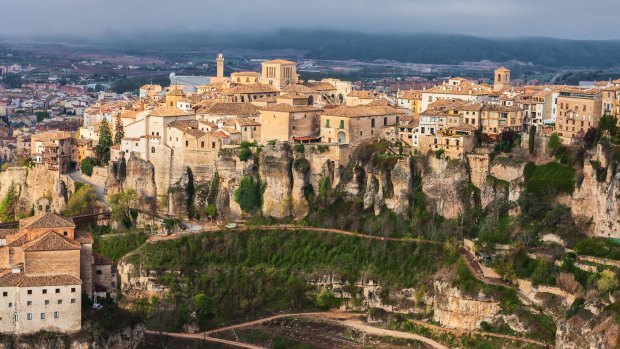
Hanging Houses in the medieval town of Cuenca, in Castilla La Mancha, Spain. Credit: iStock
Spain is a country of poetry and passion. I've been here many times before and anticipate the swooning saints in gloomy cathedrals, the clip-clop of carriages through whitewashed streets and the evenings spent in tapas bars, crunching deep-fried peppers and fat olives. I expect to be lunchtime-hungry when the Spaniards are barely awake, to admire the marvels of Velasquez and Gaudi, to enjoy sunlit parks and sultry summer evenings in plazas chirpy with cafe conversations.
Spain shovels on the stereotypes in glorious, unabashed dollops, which is what keeps me returning. Somehow though, I've never noticed that the Spanish countryside is so compellingly beautiful. In all my previous visits, it seems to have gone unremarked as I focused on history-soaked towns and investigated urban delights. Of course, until now I've always been driving, which doesn't help. I've been so focused on signposts, turn-offs and trucks that I've seldom had time to glance sideways at the unfolding landscape.
But now we've trundled out of Madrid on the first leg of a 15-day Insight Vacations journey around Spain and Portugal and I've been struck by the revelation that there are things you never see properly from a car. On a coach, things are different. You sit high above motorway safety barriers and embankments, and are freed from the shackles of the steering wheel. Now beyond the windows I can admire the stark landscape of Castile, much celebrated in Spanish literature. The fortified city of Avila bulges with towers and turrets like a conjured-up set for Game of Thrones.
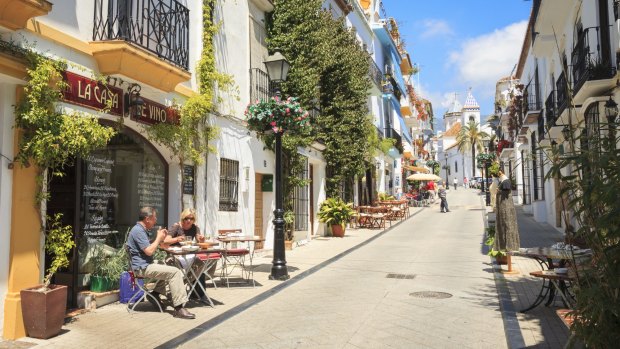
A side street in Marbella Old Town with bars and restaurants.Credit: iStock
The countryside between Avila and Salamanca is softer, cupped between distant mountains dusted with snow. Rapeseed is bright yellow as a trumpet fanfare. Neatly ploughed earth is rich brown, and fields of young barley and wheat are tinged with fresh green. Olive trees crosshatch the hillsides like a pointillist's painting. Villages huddle under terracotta roofs and are anchored by enormous churches in which you imagine – this being Spain – that saints are weeping.
As we slide into Salamanca all I have to do is stare out the window at passing Renaissance facades and schoolkids and fruit shops tumbling with tomatoes. I'm high enough to see onto the cracked faces of gargoyles on churches, and into open windows. You get a bit of voyeuristic titillation on a coach, whose raised outlook makes you feel like a petty Greek god looking down on the antics of humans.
No need to study the GPS, wonder about the speed limit, worry about arcane traffic rules. No nervousness at honking from behind you. No problems finding parking. The coach just draws up outside our hotel and off I hop, baggage following somewhere in my wake.
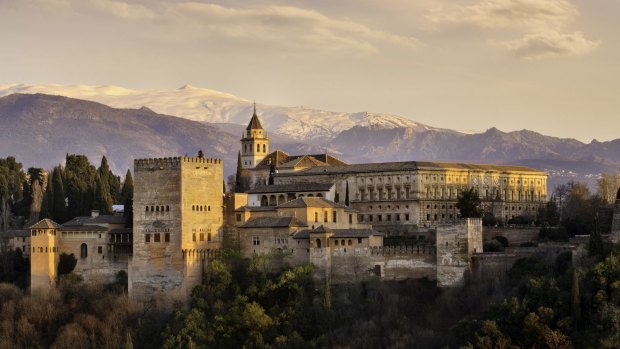
The Alhambra in Granada in southern Spain.Credit: iStock
This journey is one that brings us to the chief sights of Spain and Portugal, providing an effervescence of gothic churches, baroque art and ancient towns. Ironic, then, that I'm finding my in-between time on the coach just as enjoyable. The coach is a fancy Mercedes-Benz affair with business-class legroom in which I can stretch out and turn my face towards the panoramic windows.
As we slide over the border into Portugal, the landscape suddenly gets drier and steeper and is studded with giant boulders. Towards the coast, though, we pass through green country enveloped in morning mists. Small-scale agricultural fields are ragged at the edges, dissolving into scrubland. The flanks of valleys are stitched with rows of vines.
Our travel director Elena provides occasional commentary. She seems to know every passing sight in Spain. This notable town, that castle connected with medieval national hero El Cid, the Portuguese church linked to an improbable apparition. If there's anything she doesn't know about life here, no guest thinks to ask the question. She's a walking Wikipedia with tangled hair and an ex-smoker's throaty laugh. Her love for bad, increasingly risque jokes and random anecdotes amuses us on the road.
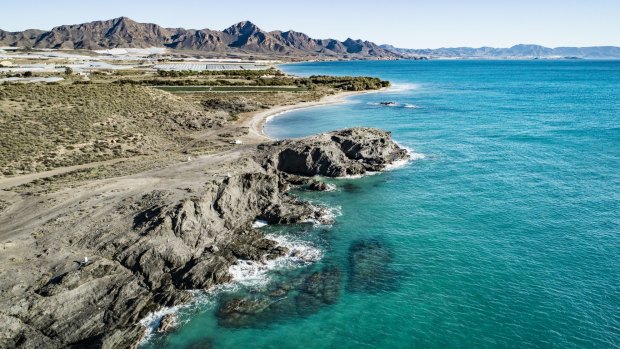
Coast in Mazarron at Percheles beach, Murcia, Spain.Credit: iStock
After a couple of days exploring Lisbon, off we go again. As we cross the 12-kilometre Vasco da Gama Bridge, my perch by the coach window has me sitting well above the railings. There are spectacular views of the Portuguese capital and vast Tagus River. As we near the far bank, I spot locals wading in the shallows, collecting clams. Suddenly and unexpectedly, flamingos appear, pretty pink exclamation marks on a blue background. Then the early morning sun is shining through cork trees. Fields are flushed with yellow wildflowers, and storks strut along the marshy flanks of rivers.
We're on the road a fair bit on this wide-ranging guided holiday across Iberia, and we all rotate through the coach so everyone gets their turn at front and back – and the chance to interact with new neighbours across the aisle. I soon get to know many of my travelling companions, and our conviviality is reinforced during organised meals and over breakfast. Most of us are Australians, on an escorted journey not because we need mollycoddling but rather for the convenience. We relish our free time, quickly scattering to follow our own interests, but have plenty to talk about when we're reunited.
A few days later, the drive out of Granada is stunning. The motorway plunges through rocky defiles with views across the valley to the snow-capped Sierra Nevada. Whitewashed villages sit on outcrops surrounded by skirts of olive trees and poppy-studded wheat fields. Then we're beyond Andalusia and down into the drier, rockier, less wealthy Murcia region, driving past troglodyte houses and small farms backed by serrated blue hills.
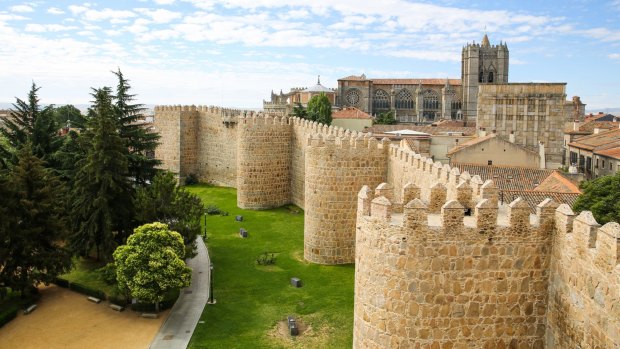
Medieval wall of Avila, Spain.Credit: iStock
There are landscapes to marvel at all the way up the Costa del Sol. Spain's scenery doesn't falter until we're into the outskirts of Barcelona, and I'm gazing out to a tangle of flyovers and factories. It's the only ugly corner of Spain or Portugal I've seen on this entire Insight Vacations trip. Yet soon it slides away, and we're travelling down an avenue lined by jacaranda trees and art nouveau buildings. Another lovely outlook unfolding beyond the coach's windows, right at journey's end.
FIVE ARCHITECTURAL HIGHLIGHTS
ROMAN AQUEDUCT, SEGOVIA
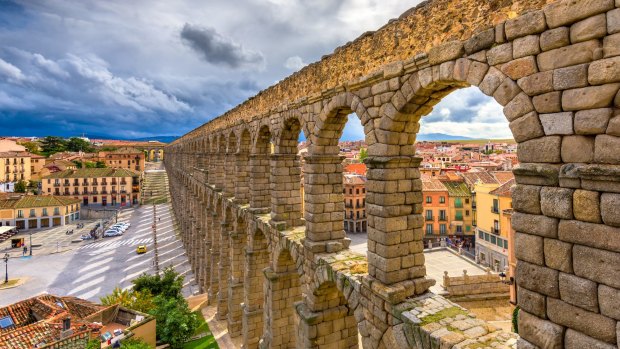
The ancient Roman aqueduct in Segovia, Spain.Credit: iStock
This 2000-year-old aqueduct, built of granite blocks, doesn't just have a beautiful (and deceptive) simplicity but is a remarkable feat of engineering that supplied water to Segovia until the late 19th century. Its 166 arches parade right through the town centre above rooftops and roads. It's one of the world's best-preserved Roman aqueducts, and very impressive. See turismodesegovia.com
JERONIMOS MONASTERY, LISBON
Gothic and Moorish architecture combine to form the distinctive and very elaborate early 16th-century Portuguese Manueline style in this monastery, whose cloisters and chapel have especially ornate stonework and elegant vaulting. The chapel houses the tombs of poet Luis de Camoes and great explorer Vasco da Gama, about whom our Insight local expert is very informative. See mosteirojeronimos.gov.pt
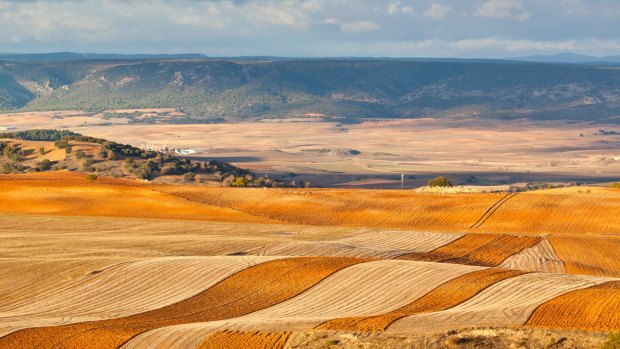
Fields and hills of Castilla-La Mancha, Spain.Credit: iStock
ALHAMBRA, GRANADA
This vast fortified, hilltop palace and garden complex was added to over a millennium. The highly embellished, medieval Islamic courtyards and reflecting pools at its core are the highlight, and Islamic Spain's greatest monument. Further along the hill, Generalife summer palace features lavender walkways, rose beds and splashing fountains with romantic outlooks over town. See alhambra-patronato.es
CITY OF ARTS AND SCIENCES, VALENCIA
This building complex includes an opera house, science museum and planetarium, all in startlingly white contemporary architecture superbly reflected in surrounding pale blue pools. It rightly put Valencia on the map when it opened over the turn of the millennium. Evening views over it from the rooftop bar at Insight Vacation's hotel are magnificent. See cac.es
SAGRADA FAMILIA, BARCELONA
The Church of the Holy Family, Catalan artist Antoni Gaudi's defining masterpiece, was begun in 1882 and remains a work in slow progress. It's a fanciful wonder of surreal, twisting towers with art nouveau influences but its own eccentric style. The interior is a must-visit. A guide will enhance your appreciation of its rich symbolism. See sagradafamilia.org
TRIP NOTES
Brian Johnston travelled as a guest of Insight Vacations.
MORE
TOUR
Insight Vacations' popular 15-day Best of Spain and Portugal itinerary between Madrid and Barcelona (or the reverse) runs weekly from April to October and visits destinations including Salamanca, Porto, Lisbon, Seville, Gibraltar and Granada. Prices from $4727 a person twin share including some meals, Insight Experiences, a travel director and local specialist guides. See insightvacations.com/au
Sign up for the Traveller Deals newsletter
Get exclusive travel deals delivered straight to your inbox. Sign up now.